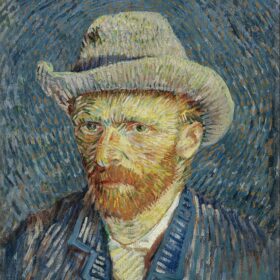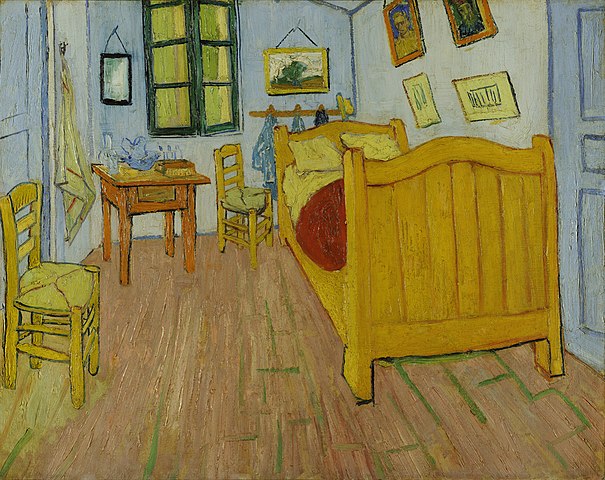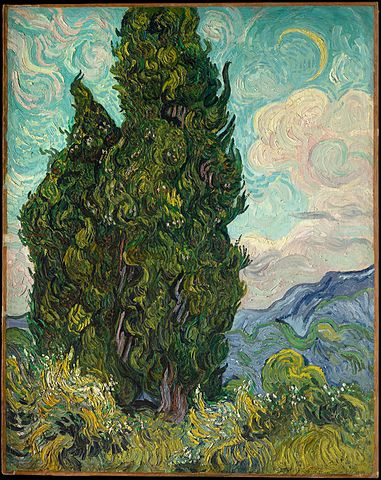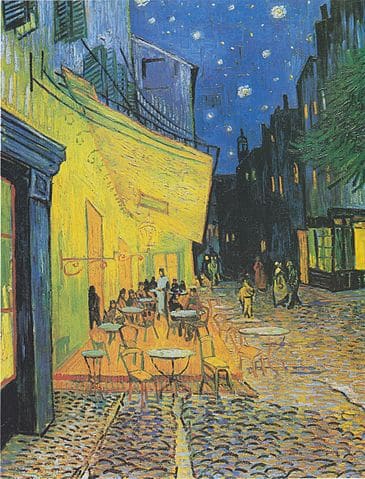If you’re looking for inspiration for your Style Transfers, there’s no style as iconic as Van Gogh’s. This article is a detailed guide to everything about his style. Since he painted at the turn of the century, people often confuse if his style is impressionism or expressionism. I was confused originally too! I’ll answer all your tough questions with this detailed impression of Van Gogh’s style.
As a whole, Van Gogh was both an impressionist and an expressionist. At the time, he would have considered himself to be an impressionist. Today, however, Van Gogh is considered one of the pioneers and founders of the expressionism movement.
I’ll break down the definitions of each movement and cover how they influence Van Gogh’s artistic style. Since it came first, I’ll start with impressionism!
Impressionism: What is the Black Thing in Starry Night?
Table of Contents
The impressionism movement consists of artists whose paintings gave general impressions of scenes and didn’t focus on the finer details. I’ll cover what this style looks like starting with a famous Van Gogh example: What is the black thing in Starry Night?
The black thing in Starry Night is a stylized cypress tree in the dark. Van Gogh liked how these trees looked and painted them on multiple occasions. The trees are an example of impressionism since the painting only gives the viewer ‘the impression’ and not the realistic intricate details.
There were multiple techniques impressionist painters used to convey these general ideas. They were known for using shorter brush strokes and having unique coloring techniques. You can also see this in Van Gogh’s Sunflowers painting, though what we see is not in the original yellows. I’ll cover these techniques before we move on to expressionism. [1]

Techniques of Impressionist Painters
Something of primary focus to impressionist painters was the light in the scenes that they painted. When capturing the momentary feeling of a scene or subject, if the painter took too long the moment would pass. The light would change, and the artist would be painting a different scene.
For this reason, impressionists had short brush strokes which looked hasty, sloppy, or rushed. The artist was in a constant race against the light to capture the fleeting beauty of the moment. Impressionists also had little time for the mixing of paint and often used pure and more intense colors. The short strokes produced a distinctive texture to the paintings. [4]
| # | Famous Van Gogh Painting | Year Painted | Current Location |
|---|---|---|---|
| 1 | The Potato Eaters | 1885 | Amsterdam Van Gogh Museum, Netherlands |
| 2 | Bedroom in Arles | 1888 | Art Institute of Chicago, United States |
| 3 | Cafe Terrace at Night | 1888 | Kroller-Muller Museum, Netherlands |
| 4 | Sunflowers | 1888 | National Gallery London, United Kingdom |
| 5 | Portrait of Dr. Gachet | 1890 | Musee D’Orsay Paris, France |
| 6 | Almond Blossom | 1890 | Amsterdam Van Gogh Museum, Netherlands |
| 7 | Cypresses | 1889 | Metropolitan Museum of Art, New York United States |
| 8 | Self Portrait, Gray Hat | 1887 | Amsterdam Van Gogh Museum, Netherlands |
| 9 | Self Portrait, Bandaged Ear | 1889 | Courtauld Institute of Art, London United Kingdom |
| 10 | Starry Night | 1889 | Museum of Modern Art, New York United States |
The impressionists were known for ‘impasto’ painting where the paint is applied very thick and sometimes mixed right on the painting. It gives the style a ‘texture’ from the visible brush or knife strokes on the canvas.
Impressionist painters were also known for using complementary colors within the same area of a painting. These colors were bright and contrasting. Rather than spending time to mix the paint, a common technique was to use ‘optical mixing’, where quick brush strokes or hatches of the component colors would make the color appear to be a mixed color from far away.
So we covered impressionism, but what about expressionism? Van Gogh is considered to be one of the early pioneers of expressionism.

Why is Van Gogh Considered a Father of Expressionism?
Expressionism paintings are more abstract and use color to express feeling and mood rather than using the real color of the objects. During the end of the impressionist movement, the camera was invented. All of a sudden, a device could instantly capture a scene.
It started to become less impressive that a human could reproduce an ordinary scene in a painting. All of the racing impressionists did to quickly capture light? Done in a click! Artists had to become more abstract and more creative to capture the imagination of their viewers.
Van Gogh is considered a father of expressionism because his paintings used color to express his personal feelings, mood, and symbolism rather than using the object’s real color. The paintings were more abstract and influenced many of the expressionists who followed.
Van Gogh began his career as an impressionist, however since his paintings were deeply personal and often more abstract he is considered a post-impressionist or expressionist today. He painted using color to express symbolism, meaning, and feeling. I’ll let Van Gogh himself explain as he did in a letter to his brother Theo: [7]
I should like to paint the portrait of an artist friend, a man who dreams great dreams, who works as the nightingale sings, because it is his nature. He’ll be a blond man. I want to put my appreciation, the love I have for him into the picture. So I paint him as he is, as faithfully as I can, to begin with.
Van Gogh
But the picture is not yet finished. To finish it I am now going to be the arbitrary colourist. I exaggerate the fairness of the hair, I even get to orange tones, chromes and pale citron-yellow.
Behind the head, instead of painting the ordinary wall of the mean room, I paint infinity, a plain background of the richest, intensest blue that I can contrive, and by this simple combination of the bright head against the rich blue background, I get a mysterious effect, like a star in the depths of an azure sky.
The beauty and skill of Van Gogh’s paintings helped inspire a new generation of artists who were not tied to painting ‘realistic’ scenes or worried about the photo-like accuracy of the light in scenes. Color, feeling, mood, expression! These were the new tools of the day. You can definitely see this in the color and textures of Starry Night. To me, the painting reminds me of the flowing fractal shapes.
Techniques of Expressionism
Generally, the expressionists were not tied to forms by the nature of the artwork they created being so abstract. However, once the movement formed the early German Expressionists moved to define the style.
Often, expressionist painters used quick brush strokes like their impressionist forbearers, however, they more often made forms jagged, rough, and abstract. An object which would have been recognizable in an impressionist painting becomes warped, distorted, and discolored in an expressionist painting.
| Artist Facts | Info |
|---|---|
| Full Name | Vincent Van Gogh |
| Date of Birth | March 30, 1853 |
| Date of Death | July 29, 1890 |
| Location | Zundert Netherlands |
| Movements | Impressionism, Expressionism |
| Artistic Focus | Paintings, Drawings |
| Favorite Medium | Oil on Canvas |
The expressionists imbued spiritual life and energy into their paintings, often feeling dynamic and moving. Something which the beautiful scenes depicted by expressionism lacked. The artists often focused on feeling and depicted their anxieties, fears, worries, and frustrations.
Van Gogh was notorious for making his paintings deeply personal. For example, Van Gogh had a breakdown at one point in his life and is famous for cutting off his own ear. He immediately painted a self-portrait and checked himself into a mental hospital.

The hospital is the location at which he painted Starry Night, and actually did not depict the bars on the window of his room. The painting is full of the abstract shapes of the night and vivid color. There is turbulence in the painting that reflects the artist’s state at the time. [5]
What Colors Did Van Gogh Use?
Color is a huge component of an artist’s style and Van Gogh is no different. There are aspects of color unique to impressionists generally and aspects that are unique to Van Gogh himself. Everyone has a favorite color, what was Van Gogh’s?
As a general rule, Van Gogh used color creatively with striking hues that invoked emotion and influenced mood, rather than using the object’s realistic colors. Van Gogh often used bright blue, teals, ultramarine, vermillion orange, yellow ochers, bright whites, deep greens, and red ocher.
According to a letter Van Gogh sent when he was 35, the full list of colors is as follows: [6]
Reds
- Vermillion
- Geranium
- Cochineal Lake
- Madder Lake
Whites
- Zinc White
- Lead White
Greens
- Viridian
- Emerald Green
Blues
- Cobalt Blue
- French Ultramarine
- Prussian Blue
Orange
- Chrome Orange
Yellows
- Chrome Yellow Light
- Chrome Yellow Medium
- Zinc Yellow
- Vandyck Brown
The colors of Van Gogh’s paintings created a dynamic feeling of movement within the painting and have even been the subject of scientific studies. [2] They are an incredible component of his style, but they are not the only characteristic of interest. Art materials influence how color is applied and perceived.

Van Gogh’s Favorite Materials
The materials of any artist are a huge influence on their style. The materials are the tools that allow the artist to turn their works from ideas into masterpieces. For his style it is important to know: What materials did Van Gogh use?
As a whole, the materials Van Gogh used were oil paint, round brushes, and a canvas. Some of his most famous works were painted ‘impasto’ where the oil paint is rapidly applied in short strokes, straight from the tube. He also drew in pen and ink and painted occasionally in gouache and watercolor.
Van Gogh’s artistic materials are:
- Oil Paint
- Pallet Knives
- Bristle Brushes
- Round Brushes
- Pen
- Ink
- Easel
- Watercolor
- Gouache
- Charcoal
- Perspective Frame
The way oil paint interacts with the canvas is a key component of Van Gogh’s style and makes the contrasting colors look sharp and alive for the viewer. Where and how people view Van Gogh’s paintings is still being studied today. [3]
A crucial part of any artwork is the medium it uses. ‘The medium is the message’ would not be a common expression in Van Gogh’s time, but the quote highlights an important truth about style.

What Medium Did Van Gogh Use?
One large part of an artist’s style is the medium on which they are creating their art. The medium affects how the materials like the paint and brush are applied. For Van Gogh, he certainly had a favorite:
As a general rule, Van Gogh painted on canvases when he created his famous oil paintings. On rare occasions, he would use a cheaper board material called carton. In one instance, he was without materials in a psychiatric hospital and painted on towels.
A list of Van Gogh’s artistic mediums is as follows:
- Canvas
- Carton
- Ingres paper
- Laid Paper
- Wove Paper
- Once: A Towel
- Once: An envelope
The artist’s medium is the ‘envelope’ they are using to wrap and send their message to the viewer. It is a vital aspect of the artwork and should be considered in any analysis of an artist’s style.
Using Van Gogh’s Style in Your Own Transfers
Now that you’re an expert in Van Gogh’s style you can use it in your own paintings and style transfers! Since Van Gogh used color to convey mood and symbolism instead of realism, it’s a perfect style to transfer to other images.
The style transfer will often make the output image a more abstract one, so you too can follow in Van Gogh’s footsteps and use the color and style for symbolism and meaning.
Want to explore the style of another influential artist? Check out my style guide for Claude Monet
References
- Monico, Letizia, et al. “Evidence for Degradation of the Chrome Yellows in Van Gogh’s Sunflowers: A Study Using Noninvasive In Situ Methods and Synchrotron-Radiation-Based X-ray Techniques.” Angewandte Chemie 127.47 (2015): 14129-14133. https://medialibrary.uantwerpen.be/oldcontent/container2832/files/Monico_et_al-2015-Angewandte_Chemie_International_Edition.pdf
- Monico, Letizia, et al. “Degradation process of lead chromate in paintings by Vincent van Gogh studied by means of synchrotron X-ray spectromicroscopy and related methods. 1. Artificially aged model samples.” Analytical chemistry 83.4 (2011): 1214-1223. https://www.academia.edu/download/36495606/2011_yellow_AC_1.pdf
- Walker, Francesco, et al. “Looking at paintings in the Vincent Van Gogh Museum: Eye movement patterns of children and adults.” PloS one 12.6 (2017): e0178912. https://journals.plos.org/plosone/article?id=10.1371/journal.pone.0178912
- Li, Jia, et al. “Rhythmic brushstrokes distinguish van Gogh from his contemporaries: findings via automated brushstroke extraction.” IEEE transactions on pattern analysis and machine intelligence 34.6 (2011): 1159-1176. https://ieeexplore.ieee.org/abstract/document/6042878
- Aragón, José Luis, et al. “Turbulent luminance in impassioned van Gogh paintings.” Journal of Mathematical Imaging and Vision 30.3 (2008): 275-283. https://arxiv.org/pdf/physics/0606246.pdf
- Letter 475 – A letter from Vincent Van Gogh to his brother Theo. http://www.webexhibits.org/vangogh/letter/18/475.htm
- Letter 520 – A letter from Vincent Van Gogh to his brother Theo. http://www.webexhibits.org/vangogh/letter/18/520.htm
